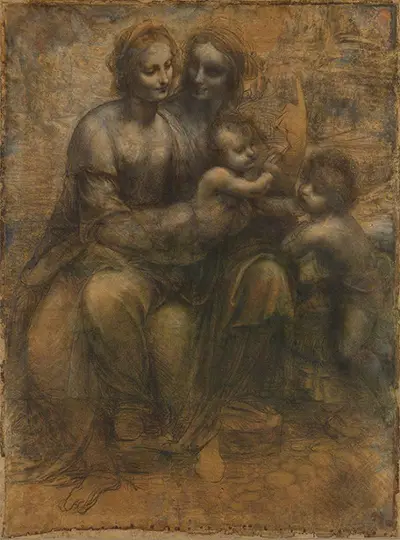The theme of the Virgin and Child with St Anne was a popular one in 15th century Florence.
The cartoon is widely believed to have been preparatory work for a painting due to its size, it is drawn over eight sheets of paper and is over 140 cm (55 inches) high.
But the drawing has not been pricked for transfer to canvas and no painting by Leonardo da Vinci matches the composition. Da Vinci's painting The Virgin and Child with St Anne, which hangs in the Louvre, omits St John and has a more rigid and less naturalistic composition.
Drawn in charcoal and chalk on tinted paper, the cartoon is a good example of da Vinci's complex composition and realism. The eye follows St Anne's gaze to her daughter Mary who in turn looks adoringly at the Christ child. The children are curious, Jesus wriggles away from his mother and holds his hand up as if in blessing towards his transfixed cousin.
Christ's innocent expression mirrors his mother's while John's recalls the more knowing look of his grandmother. St Anne's hand points upwards towards heaven, between the faces of the two young boys. However the religious symbolism does not intrude on the intimacy of this charming family portrait. As Anne and Mary seem to be sharing a private moment, so do John and Jesus.
The light settles on Mary and Jesus, making it clear that they are the focus. Anne and John are more shaded. Again this draws attention to the link between Mary and Jesus, and their innocence compared to Anne and John's relative worldliness.
The structure is a loose pyramid. There is a strong diagonal line from the faces of the women to the boys, and another created by the knees of the women and the shoulder of St John.
The Cartoon of St Anne, also known as the Burlington House Cartoon after the London home of the Royal Academy of Arts, now hangs in the National Gallery in London. In 1962 it was put up for sale but was considered so important that the National Arts Collections Fund, along with donations from the public, raised sufficient money to keep it in the United Kingdom.
In 1987 is was vandalized with a shotgun causing extensive damage, which has since been repaired.
Although unfinished, the work is widely considered a masterpiece. The faces and torsos are beautifully rendered as are the folds of the clothing. The natural and meaningful poses and expressions of the group are unmatched even in da Vinci's finished paintings.


